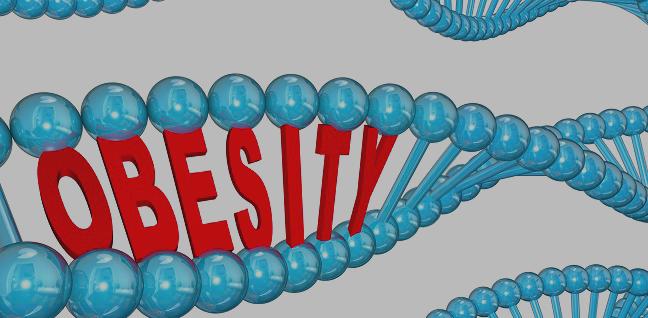Genetics Only Weakly Predicts Midlife BMI for Young Adults
The results suggest obesity prevention efforts should not focus on polygenic risk scores, but rather on BMI in young adulthood.

When it comes to predicting midlife body mass index (BMI) in young black and white adults, a polygenic risk score (PRS) for obesity isn’t up to snuff, with BMI at baseline and over time being more informative, a new CARDIA analysis shows.
Adding a PRS to a model that included age, sex, and self-reported history of parental overweight only modestly improved its ability to explain variation in BMI either at baseline, when participants were age 25 on average, or at the 25-year follow-up visit, according to researchers led by Venkatesh Murthy, MD, PhD (University of Michigan, Ann Arbor).
The strongest explanatory factor for variation in BMI at either time point was BMI in young adulthood, they report in a study published online January 8, 2020, ahead of print in JAMA Cardiology. Including serial measurements of BMI explained about 80% of the variance in body mass throughout the study period.
“For clinical purposes, when you’re dealing with young adults and probably for older adults as well, having simple measurements of people’s weight and height and calculating a BMI from that carries way more information than any of these more sophisticated tests,” Murthy told TCTMD. He added that serial measurements of BMI “should be [at] the core of how we counsel our patients for prevention of overweight and obesity. Genetics is likely to have a pretty limited impact, at least as currently formulated in today’s polygenic risk scores.”
Ruth Loos, PhD (Charles Bronfman Institute for Personalized Medicine, Icahn School of Medicine at Mount Sinai, New York, NY), is a self-described skeptic when it comes to polygenic risk scores, “mainly because they’re overhyped.” Commenting for TCTMD, she said it’s not surprising that information on BMI was more informative than the PRS for predicting midlife body mass.
“That is actually nothing new,” said Loos, director of the Genetics of Obesity and Related Traits Program at Mount Sinai. “We’ve known for a long time that obesity, BMI, tracks throughout the life course. Individuals, even children, who have a higher BMI than their peers . . . will likely continue throughout life to be at a higher BMI [and] be at a higher risk of obesity. It’s very hard to get off that track.”
One thing to note, Loos said, is that baseline BMI already incorporates the genetic susceptibility represented by the PRS, as well as the fitness and activity levels Murthy et al also evaluated. “If you try to statistically add the PRS to a model that has baseline BMI, it cannot add anything because it’s already in there,” she explained.
The key open questions for Loos revolve around what put these young adults in the CARDIA study on a track for higher BMIs in the future, with genetics, environmental exposures, socioeconomic status, and family history all likely playing a part.
What’s Influencing BMI Trends?
To examine how polygenic risk, cardiorespiratory fitness, physical activity level, parental history of overweight, and BMI in young adulthood relate to BMI trends over time, the investigators turned to the CARDIA study, which targeted four US metropolitan areas to enroll black and white individuals ages 18 to 30 back in the mid-1980s. Participants were followed up periodically for 25 years.
This new analysis included 1,608 white participants (52.7% women) and 909 black participants (60.3% women). At baseline, when the mean age was 25.1 years, average BMI was 24.2 kg/m2. Twenty-five years later, when the mean age was 50.3, average BMI had risen to 29.6 kg/m2.
We’ve known for a long time that obesity, BMI, tracks throughout the life course. . . . It’s very hard to get off that track. Ruth Loos
Among white participants, a model containing age, sex, and self-reported parental history of overweight explained 6.9% of the variance in BMI at baseline and 5.1% of the variance at 25 years.
Adding a PRS derived in a prior study, along with 10 principal components of ancestry, to the model only slightly improved those figures (to 11.9% and 13.6%, respectively). The addition of physical activity levels had a minimal effect, whereas considering cardiorespiratory fitness in the basic model bumped the proportions of BMI variance explained at baseline and 25 years to 24.0% and 18.1%, respectively.
When baseline BMI or serial BMI measurements over time were included in the base model, however, none of the other variables—the PRS, activity, or fitness—provided much additional information when it came to variation in BMI at various time points. In fact, the base model plus baseline BMI explained 74.6% of variance at 5 years and 52.3% in midlife, with serial measurements taking those figures over 80%.
Findings were roughly similar in black participants.
Potential Downsides of Genetic Testing
Senior author Ravi Shah, MD (Massachusetts General Hospital, Boston), told TCTMD that even though the PRS did not add much value in predicting future BMI in this study, genetics does have a role in certain cases—in people with familial obesity syndromes or genetic defects underlying obesity. “But in the wider population where those might not be present, this study suggests that, potentially, knowing somebody’s BMI in early adulthood . . . and how it changes over time is going to be a good barometer of where they’re going to end up,” he said.
Asked about the hype surrounding use of polygenic risk scores, Murthy said “it’s clear that genetics has a lot of potential to teach us about the mechanisms of disease and where we might consider using drugs or how exercise and diet might influence cardiovascular [disease], obesity, metabolic diseases.”
But when it comes to routine clinical use of these scores, which has been advocated by some, “I think my concern is that much of the validation has not focused on how these add to very standard, commonly available measurements” like BMI, Murthy said. “From my perspective, any time we’re evaluating new measurements, particularly things that could be either expensive or come with added risk from making those measurements, we really need to show that they have added value beyond what’s already out there. And in this case, I think we’ve shown that there might be a little bit of added value, but it’s pretty modest.”
Any time we’re evaluating new measurements, particularly things that could be either expensive or come with added risk . . . , we really need to show that they have added value beyond what’s already out there. Venkatesh Murthy
Even if polygenic risk scores are going to be relatively cheap and easy to calculate, Murthy added, there are potential downsides to wider genetic testing. People may learn about susceptibility to a range of diseases, which may not be treatable and could cause anxiety, and there is the potential for false-positive findings. Moreover, there are privacy considerations to work out, he said.
“So I think that we need to take this one step at a time, demand the appropriate validation data showing that this actually makes a clinical difference, but also really think through and allow society to work through what are all the appropriate safeguards around privacy and security and how should we handle all the incidental findings,” Murthy stressed.
Look Earlier to Prevent Obesity
Both Murthy and Loos raised the idea that physicians should look even earlier than young adulthood if they want to help prevent obesity.
Because just a single measurement of BMI in young adulthood was strongly related to BMI 25 years later, “that really says that there’s value in making these measurements early and thinking about obesity prevention in young adults and perhaps even earlier,” Murthy said. He proposed that “people should make these measurements either at home or with their doctors, and they should discuss them with their doctors, because there are strategies to change the trajectory one might be on in terms of their BMI.”
Loos suggested that starting the discussion about obesity in young adulthood might already be too late. “If you’re obese at age 25, maybe it’s a good time for intervention, but maybe we should have intervened earlier because individuals who were obese in young adulthood likely were obese during adolescence and maybe as kids,” she said.
Obesity is an early-onset disease, she underscored. “Unlike many other complex diseases, such as diabetes, cancer, and cardiovascular disease, obesity starts so early on in life that if we want to predict it we need to start before it starts—so, very early on in life. And that’s why obesity prediction is more challenging than [for] other complex diseases and definitely intervention or prevention will be harder, particularly because it’s at an early age.”
Todd Neale is the Associate News Editor for TCTMD and a Senior Medical Journalist. He got his start in journalism at …
Read Full BioSources
Murthy VL, Xia R, Baldridge AS, et al. Polygenic risk, fitness, and obesity in the Coronary Artery Risk Development in Young Adults (CARDIA) study. JAMA Cardiol. 2020;Epub ahead of print.
Disclosures
- CARDIA is conducted and supported by the National Heart, Lung, and Blood Institute in collaboration with the University of Alabama at Birmingham, Northwestern University, the University of Minnesota, and the Kaiser Foundation Research Institute.
- Murthy reports being supported by research grants from the National Institutes of Health (NIH); receiving research grants and personal fees from Siemens Medical Imaging and Singulex; receiving speaking honoraria from Siemens Medical Imaging; receiving personal fees for expert witness testimony from Jubilant Draximage; serving on medical advisory boards for and receiving personal fees from Curium and Ionetix; owning stock options in Ionetix; and owning common stock in General Electric.
- Shah reports being supported by research grants from the NIH; serving as a consultant for Amgen, MyoKardia, and Best Doctors; and being a coinventor on a patent for ex-RNA signatures of cardiac remodeling.
- Loos reports no relevant conflicts of interest.


Arreka Jorkman